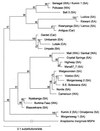Ehrlichia ruminantium major antigenic protein gene (map1) variants are not geographically constrained and show no evidence of having evolved under positive selection pressure
- PMID: 11682561
- PMCID: PMC88518
- DOI: 10.1128/JCM.39.11.4200-4203.2001
Ehrlichia ruminantium major antigenic protein gene (map1) variants are not geographically constrained and show no evidence of having evolved under positive selection pressure
Abstract
In a search for tools to distinguish antigenic variants of Ehrlichia ruminantium, we sequenced the major antigenic protein genes (map1 genes) of 21 different isolates and found that the sequence polymorphisms were too great to permit the design of probes which could be used as markers for immunogenicity. Phylogenetic comparison of the 21 deduced MAP1 sequences plus another 9 sequences which had been previously published did not reveal any geographic clustering among the isolates. Maximum likelihood analysis of codon and amino acid changes over the phylogeny provided no statistical evidence that the gene is under positive selection pressure, suggesting that it may not be important for the evasion of host immune responses.
Figures


References
-
- Adachi J, Hasegawa M. MOLPHY version 2.3: programs for molecular phylogenetics based on maximum likelihood Computer science monographs no. 28. Tokyo, Japan: The Institute for Statistical Mathematics; 1996.
-
- Awadalla P, Eyre-Walker A, Smith J M. Linkage disequilibrium and recombination in hominid mitochondrial DNA. Science. 1999;286:2524–2525. - PubMed
-
- Brayton K A, Fehrsen J, de Villiers E P, van Kleef M, Allsopp B A. Construction and initial analysis of a representative lambda ZAPII expression library of the intracellular rickettsia Cowdria ruminantium: cloning of map1 and three other Cowdria genes. Vet Parasitol. 1997;72:185–199. - PubMed
-
- De Villiers E P, Brayton K A, Zweygarth E, Allsopp B A. Genome size and genetic map of Cowdria ruminantium. Microbiology. 2000;146:2627–2634. - PubMed
Publication types
MeSH terms
Substances
Associated data
- Actions
- Actions
- Actions
- Actions
- Actions
- Actions
- Actions
- Actions
- Actions
- Actions
- Actions
- Actions
- Actions
- Actions
- Actions
- Actions
- Actions
- Actions
- Actions
LinkOut - more resources
Full Text Sources
Other Literature Sources

